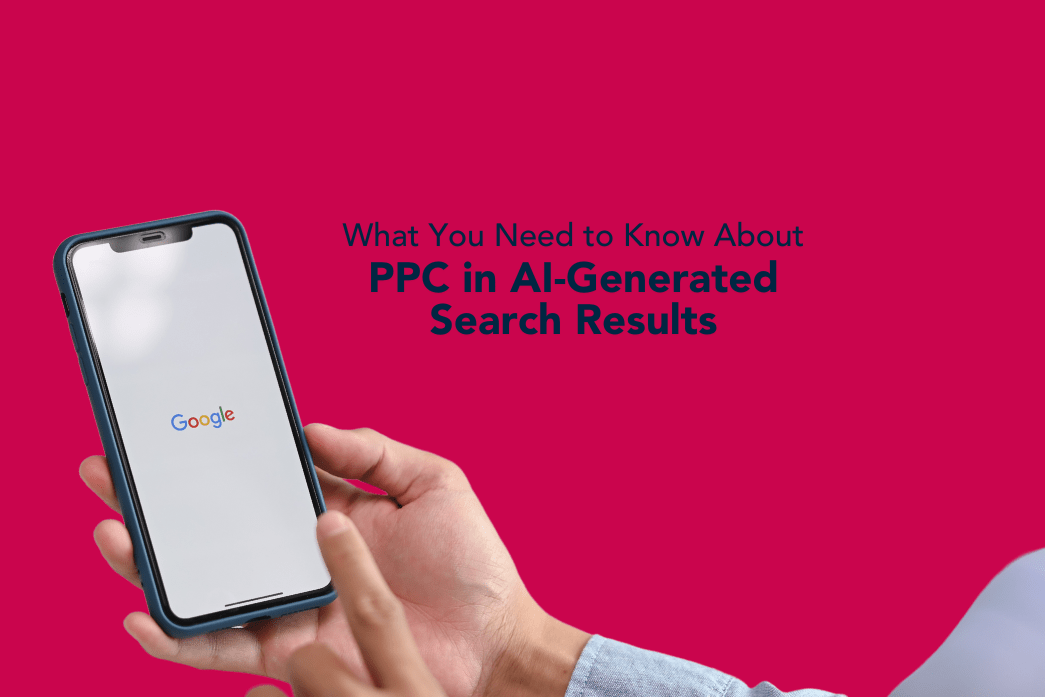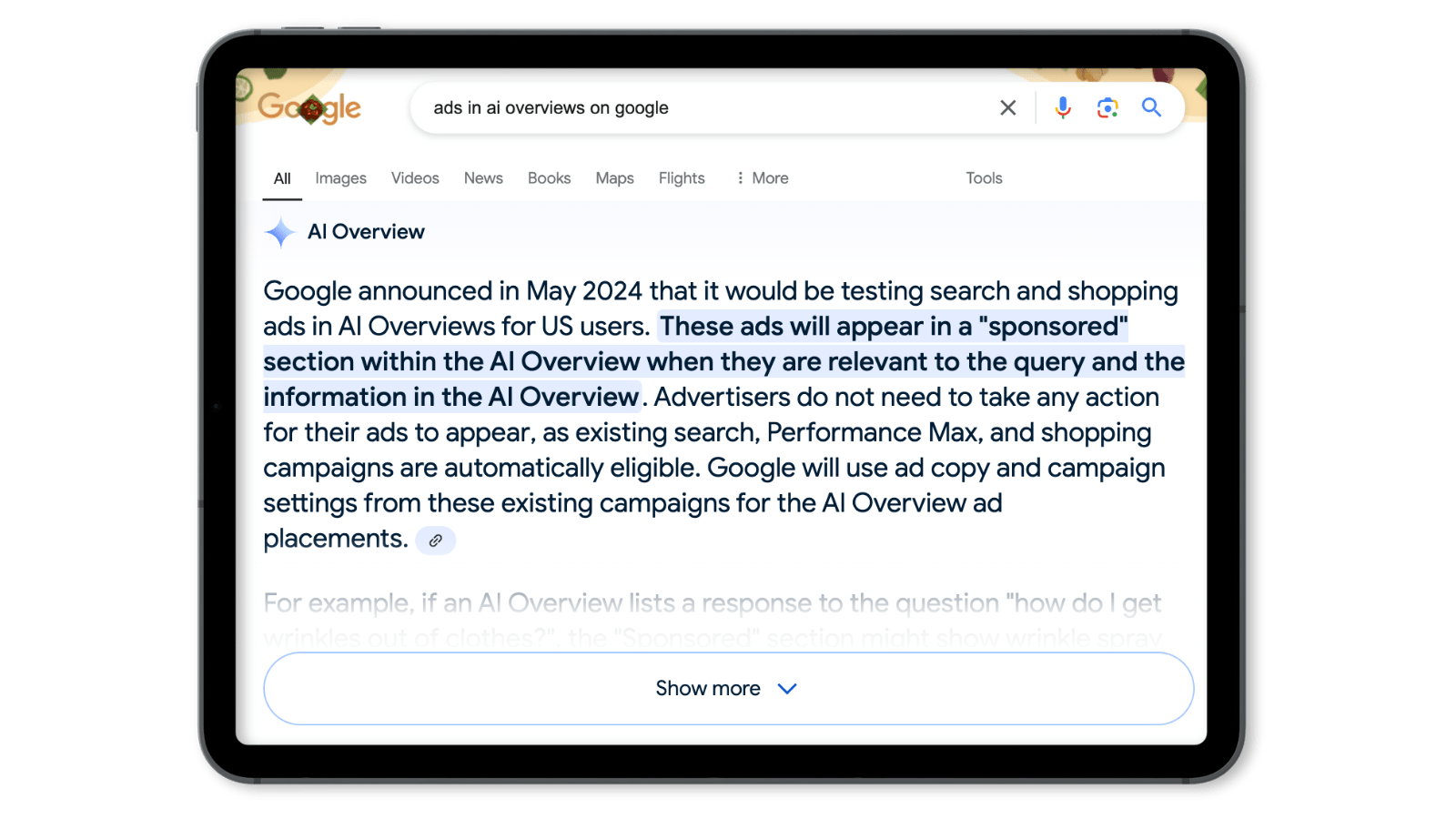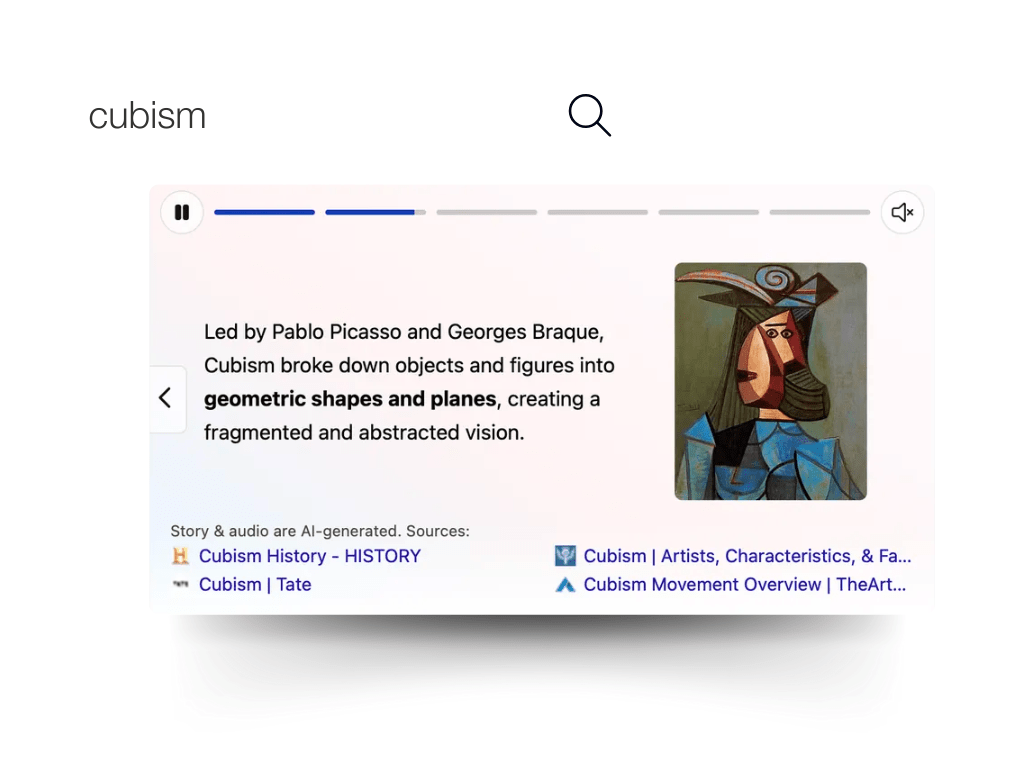
The introduction of ads in AI-generated search results – like Google’s Search Generative Experience (SGE) or Bing’s AI-powered search – marks a big shift in the world of paid search advertising. As this is a new area, early adopters who experiment and learn quickly can gain a competitive advantage.
What you need to know
- At the time of writing, Google isn’t offering a new ad format specifically for SGE. BUT – any search ads, shopping ads or Performance Max campaigns you create could be featured in AI overviews. Bing is taking a similar approach.
- AI-generated answers might reduce the visibility of traditional ads. To get your ad featured in the AI result requires precise targeting, careful keyword research and the use of natural language.
- AI-driven search results are intent-focused. You will need to align your ad strategies and targeting more closely with user intent, i.e. What is the person searching each specific keyword hoping to find?
- Ads in AI-generated results should feel natural and non-intrusive. Prioritise user experience to avoid alienating people who might expect a seamless interaction with AI-generated content.
- With AI generating more accurate and comprehensive answers, your ads need to provide additional value to earn attention. This flows back to your landing pages and content too!
- As AI-generated search results evolve, new metrics might emerge, so get ready to adapt your approach to analytics.
Google’s AI Overviews
Search Generative Experience (SGE) is a part of Google’s initiative to integrate generative AI into its search engine, creating a more dynamic and contextually relevant search experience. For PPC specialists, understanding how SGE works and its implications for Google ads will help you optimise your campaigns and long-term strategies.
How it Works
SGE provides AI-generated overviews at the top of search results, combining information from different sources to answer each user query directly. These summaries can reduce the need for users to click on traditional search results or ads. PPC in AI overviews is still in the testing phase, but advertisers who adapt their strategy now will reap the benefits.
The content in these overviews is dynamically generated and can vary from user to user. This makes the search results more contextually relevant and personalised.
- How often AI overviews appeared in search results in September 2024: 8.71% of the time
- Average length of an AI Overview: 169 words
- Average number of links in an AI overview: 7.2 links

Here’s how to get your ad featured:
- Ensure your ad copy is contextually relevant to align with the AI-generated content. High-quality, relevant ads that complement the AI overview will perform best.
- Experiment with innovative ad copy, visuals, and offers that resonate within the SGE context.
- Check what content shows in the AI overview for your target keywords (and ask colleagues to check as results are dynamic). Then try to align your ad content with the generated result. For example, if the AI is summarising product comparisons, ads that offer a clear value proposition or highlight unique features might stand out.
Watch this space
SGE is still in the early stages. From showing AI Overviews for around 64% of keywords upon the launch, Google now shows them for less than 10%. We think Google is refining the feature before featuring AI results in response to more queries.
You may have seen the criticism online when early AI Overviews presented bad advice sourced from Reddit and other community-led platforms. This was a significant blip for Gen-AI search, but we’re confident Google will retrain its models and come back stronger. Don’t underestimate the importance of this feature and the effect it will have on paid search. Similar developments are happening in generative search for higher ed, which could transform how students and educators find information. It’s an exciting space to be in!
Microsoft’s Bing AI
Bing has also introduced AI-generated results in a new feature that uses large language models (LLMs) and generative AI to create custom answers to search queries. Bing AI understands the query, reviews millions of sources, and matches content to create a dynamic response.

How it Works
Many of the Bing AI results users have shared are in a ‘Story’ format, with an AI-generated audio and narrative. They all contain a number of links.
Microsoft started trialling the feature in July 2024 with the aim to release it to more users after receiving feedback. (Users can click a ‘thumbs up’ or ‘thumbs down’ icon to make their opinions known.)
The company has already launched ads in its AI Copilot so it’s very likely you’ll be able to run Microsoft ads in AI search results soon.

“Less of your competitors are using Microsoft ads! Clicks have the potential to be cheaper, prime spots will be easier to snag, and you may get more for your money.”
– Milena Morganti, Lead PPC Specialist
Alternative Search Engines
We’re starting to see more search engines competing with Google and Bing – and they’re all AI-powered. People are also using conversational AI models where they previously would have used search. This opens up new opportunities for PPC advertisers. They’re slow coming – many of these hot new search engines work on an ad-free subscription model or simply haven’t had the time to launch an ads service yet. But we recommend keeping both eyes on emerging opportunities in paid search and getting in there as soon as possible.
Perplexity
Probably the most talked-about AI-powered search engine to emerge, Perplexity uses large language models to answer questions directly, much like a chatbot.
As of now, Perplexity does not offer PPC ads. The company is enticing new users with a clean, ad-free experience. But we think this could change as the platform grows and seeks monetisation options.
You.com
You.com is an AI-powered search engine that combines traditional search results with an AI-driven chatbot called YouChat. It also lets users customise their search experience with a number of apps and plugins.
Ads can appear within the results in a format similar to traditional PPC, but with an emphasis on relevance and integration with a user’s apps. We may see alternative ad placements as the platform grows.
SearchGPT
OpenAI is launching a new search component of ChatGPT, which was in testing at the time of writing. It will show a summary-style answer to search queries with links to sources.
Sam Altman, the CEO of OpenAI, doesn’t love ads: ‘I like that people pay for ChatGPT and know that the answers they’re getting are not influenced by advertisers.’ As SearchGPT will initially be available to ChatGPT+ members, it’s very unlikely there’ll be advertising opportunities. Once it opens up to non-paying users, though, it is possible we’ll see ads integrated.

Conclusion
It’s becoming harder to stay up to date with the latest PPC strategies and ensure top performance across platforms. Many companies that used to handle paid search internally are turning to specialists and PPC agencies to stay ahead of their competitors.
If you’re interested in working with our experts, book a free consultation today.



